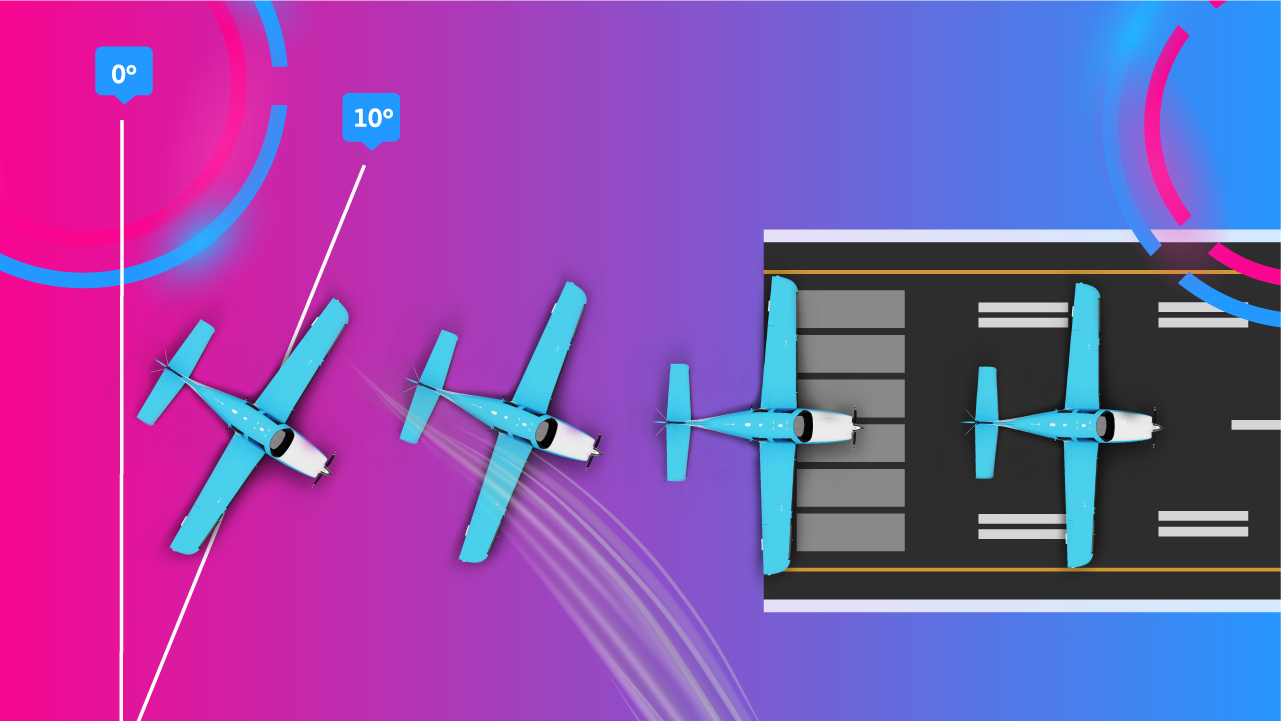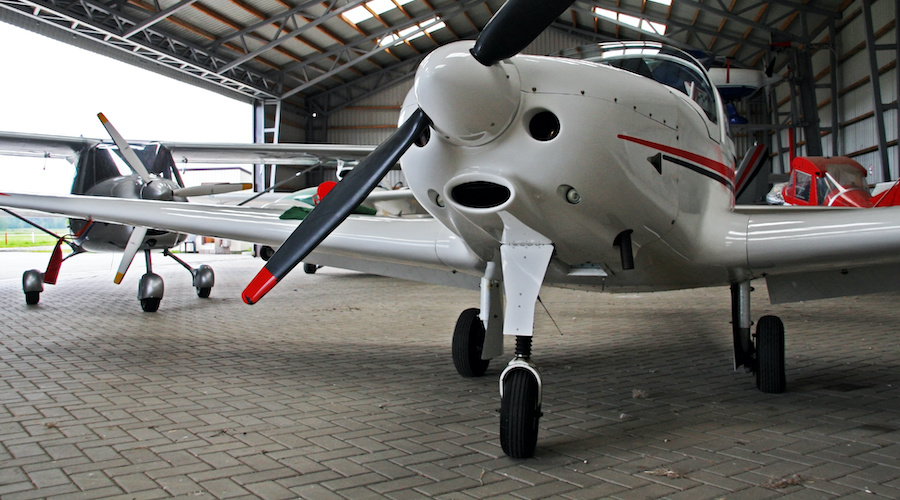-
Key Takeaways
-
Why Crosswind Landings Aren’t Easy
- Staying Aligned on the Approach
- Landing Aligned With the Runway
-
Crosswind Techniques: Crab and Sideslip
- The Crab Method
- The Sideslip Method
-
The Step-by-Step Guide to Crosswind Landings
- Plan for the Conditions
- Flying the Approach
- Roundout and Touchdown
- Rollout
-
Common Mistakes (And How to Avoid Them)
- Failing to Anticipate the Crosswind
- Exceeding Your Personal Crosswind Limits
- Overcontrolling the Aircraft
- Landing in a Crab
- Not Landing on the Upwind Wheel
- Neutralizing the Controls on Touchdown
- Flying Too Fast
-
Improve Your Crosswind Technique
- Practice Slow Flight
- Perform Low Passes
- Start Small and Build Up
-
Conclusion
Landing an airplane is not easy, even for experienced pilots.
When the wind is blowing across the runway instead of along it, things get more challenging.
But don’t hang up your headset just because the weather isn’t perfect.
In this article, we’ll cover all you need to know to confidently master crosswind landings.
Key Takeaways
- Manage crosswind landing challenges using the crab and sideslip techniques.
- Plan for crosswind conditions with step-by-step procedures.
- Learn to avoid common mistakes during approach, roundout, touchdown, and rollout.
- Discover ways to stay proficient with regular practice.
Why Crosswind Landings Aren’t Easy
Ideally, pilots want the wind to hit the aircraft dead on the nose while landing. A headwind lowers groundspeed, making landing easier.
However, the wind rarely aligns perfectly with the runway. When an aircraft lands with the wind hitting it at an angle, it’s called a crosswind landing.
We have two main challenges when performing crosswind landings:
- Staying aligned with the extended centerline on the approach.
- Touching down with the aircraft’s longitudinal axis aligned with the runway.
Staying Aligned on the Approach
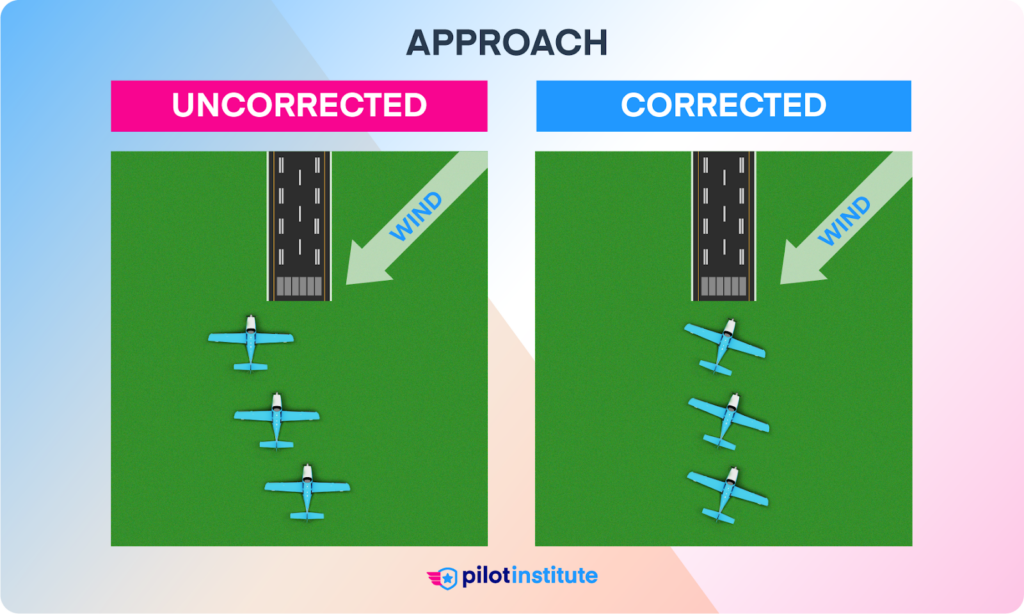
Crosswinds try to “push” the aircraft off the approach course. If the pilot makes no corrections, the aircraft gets blown off the runway centerline.
We cancel the drift by pointing the aircraft slightly into the wind. By doing so, the aircraft’s nose is no longer aligned with the runway heading. Flying toward the runway but not pointing at it feels unnatural, making this skill hard to master.
Landing Aligned With the Runway
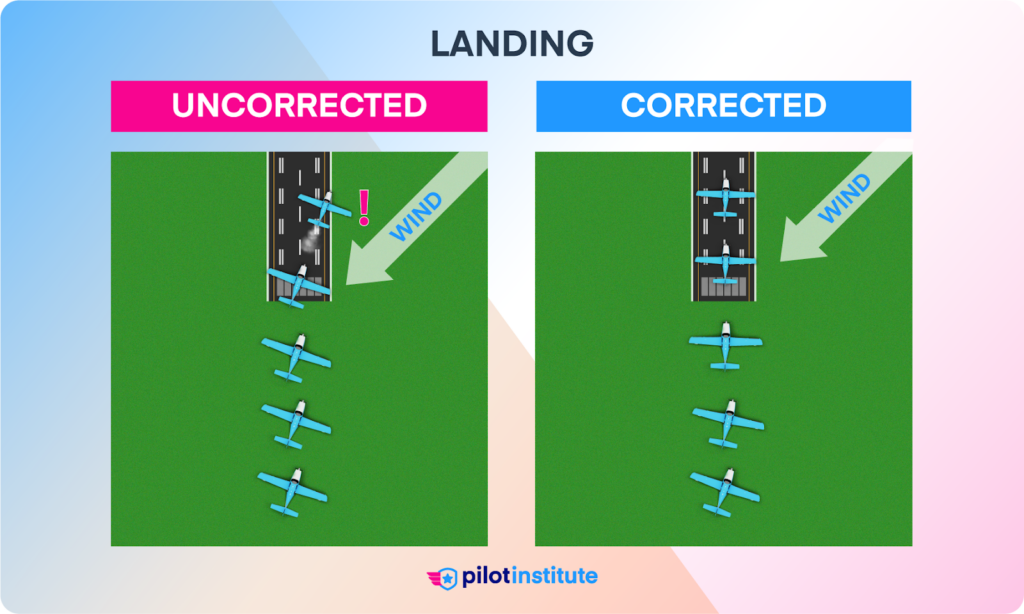
Most smaller aircraft cannot touch down with the nose pointing into the crosswind. This causes side loads on the landing gear, resulting in wheel damage or a loss of control. A runway excursion can quickly follow.
We need to align the aircraft with the runway before the wheels contact the ground. This is a tricky maneuver to perform while touching down smoothly and on centerline.
Let’s look at two methods for dealing with these crosswind landing challenges.
Crosswind Techniques: Crab and Sideslip
You will use two main techniques to land in a crosswind: the crab and the sideslip.
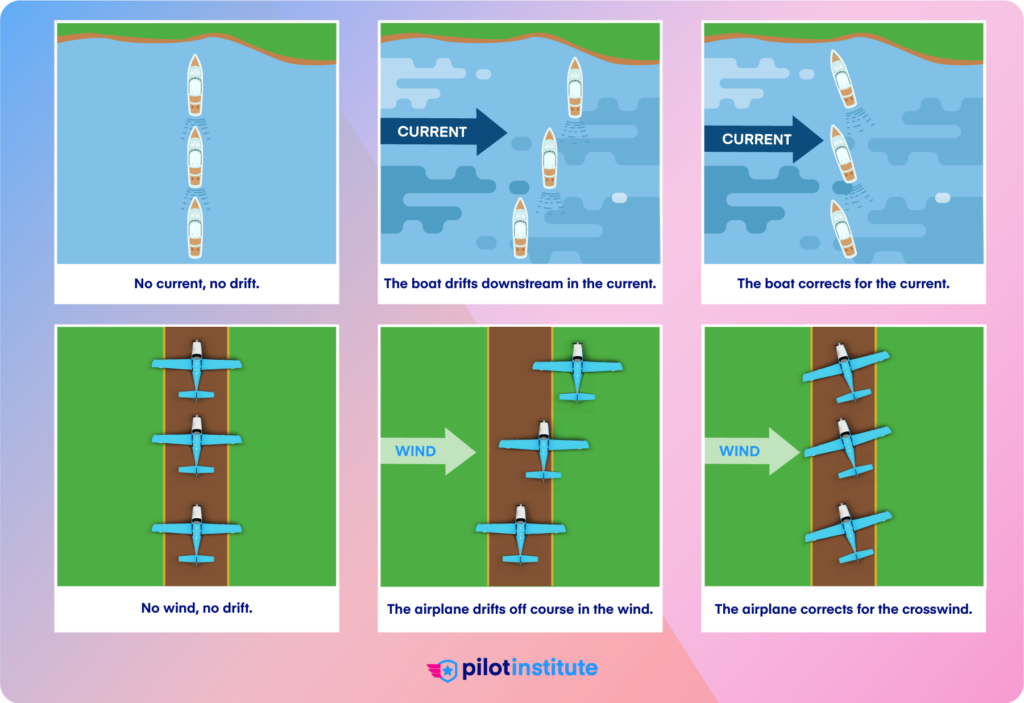
The Crab Method
Imagine a boat trying to cross a fast-flowing river. Let’s say the boat aims for the opposite bank without compensating for the current in the water. It eventually reaches the other bank, but it has drifted way downstream.
If it adjusts its course slightly upstream, it compensates for the current. It arrives at precisely the point it intends to reach.
Aircraft use the same technique. The pilot angles the aircraft’s nose into the wind, and the aircraft tracks its course sideways, kind of like how crabs walk – hence the name.
The stronger the wind and the further it blows from the runway heading, the greater the aircraft’s crab.
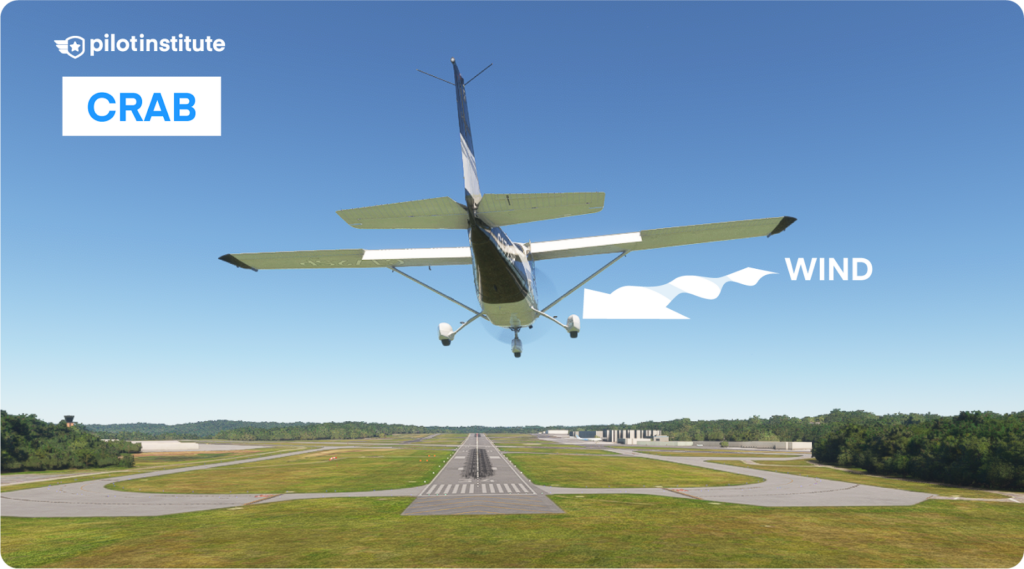
Your ailerons and rudder will be neutral once you’re in the crab position. You’ll make minor corrections to stay on course by adjusting for the changing winds.
“De-crabbing” the Aircraft
We can’t touch down with the aircraft in a crab. We must point the aircraft straight down the runway at some point before touchdown. We call this de-crabbing.
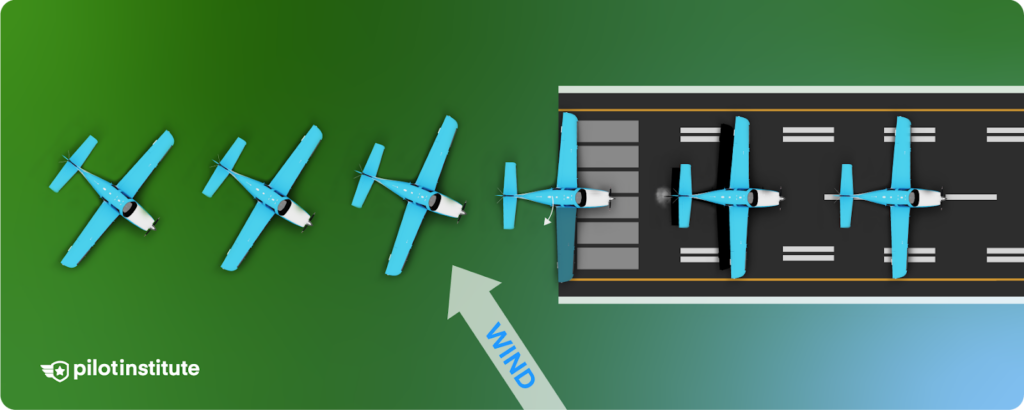
We use the rudder to align the aircraft’s longitudinal axis with the centerline. Simultaneously, we apply ailerons opposite the rudder input. The ailerons control our lateral position over the runway. We use just enough aileron input to prevent the aircraft from drifting downwind. We call this cross-controlled configuration a sideslip.
Many pilots de-crab right before touchdown. Others prefer to transition on short final.
The Sideslip Method
With the sideslip (or wing-low) method, the aircraft flies the approach cross-controlled. The pilot needs to hold aileron and rudder deflection the entire time.
The greater the crosswind, the steeper the aircraft’s bank into the wind. A higher bank requires more aileron deflection, which in turn requires more rudder.
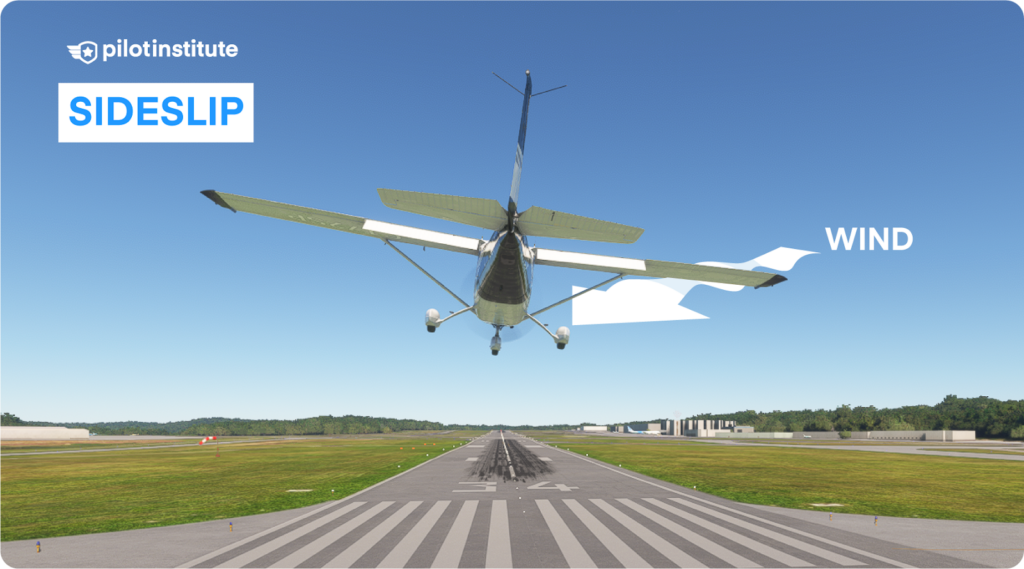
Sideslipping during the approach offers an easier touchdown than with the crab method. The aircraft doesn’t need last-minute adjustments as it’s already aligned with the runway.
However, sideslipping for the whole approach can be tiring, and the side forces can unnerve passengers. For these reasons, most pilots don’t fly the entire approach in a sideslip.
The Step-by-Step Guide to Crosswind Landings
A good crosswind landing starts before you even leave the ground. Here’s how to execute the perfect crosswind landing, every time.
Plan for the Conditions
During your flight planning:
- Look up the expected winds at your estimated arrival time.
- Use weather forecast charts, METARs, and Terminal Area Forecasts (TAFs).
- Note down the wind strength, direction, and any gusts.
- Look at the airport layout and determine the winds in relation to the available runways. The runway most closely aligned to the expected wind direction will likely be active. However, check NOTAMs for runway closures.
- Calculate the crosswind using the wind component table or a flight computer, such as an E6-B. For an estimate, use a quick crosswind shortcut.
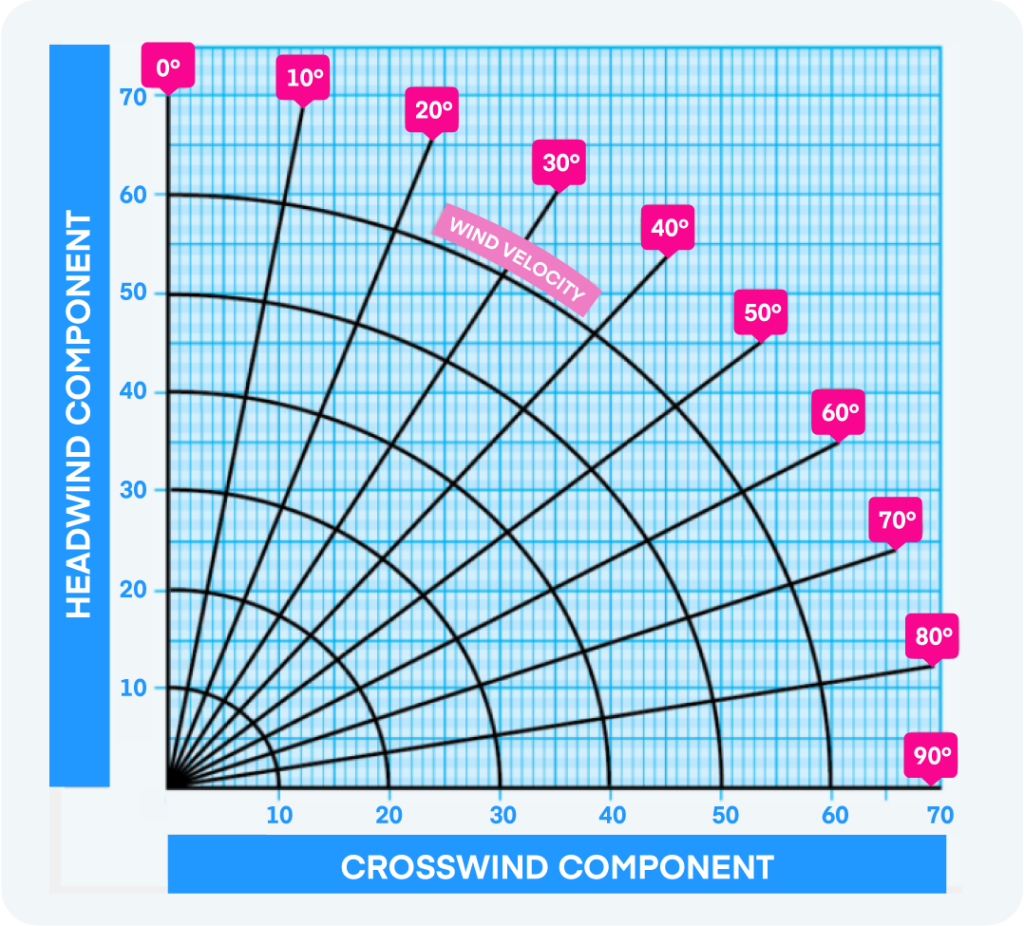
Now that you know the crosswind component, can you and your aircraft handle them?
Aircraft manuals publish a maximum ‘demonstrated’ crosswind component. That’s not a limit; it’s just the crosswind component tested by the manufacturer. So, while it’s not illegal to land in more intense crosswinds, it might not be wise to do so. Are you as skilled as a test pilot?
You should have your own personal limits written down, including the maximum crosswind you’re comfortable with.
Flying the Approach
- Getting Wind Information
Check the winds when approaching the airport. At towered fields, listen to the ATIS and ask the controller for the latest winds. At non-towered fields, check the AWOS or ASOS.
Have the winds changed since your departure weather briefing? If so, recalculate the crosswind component and verify that it’s within safe limits.
- Preparing Your Approach
Decide if you want to use the crab or the sideslip approach.
The crab method is the most comfortable way to fly the approach. A sideslip approach creates excess drag and requires more control inputs. We recommend learning to use the crab method during most of the approach.
Consider what flap setting you’ll use for the landing. Some pilot’s operating handbooks (POHs) prohibit or advise against extended slips with full flaps. If this is the case, use the crab approach method unless the winds are light. Alternatively, consider the sideslip approach method with a reduced flap setting. Check your POH for details.
If the crosswind is strong or gusting, you might want to avoid using full flaps anyway. This prevents the aircraft from pivoting into the wind (known as weathervaning).
Take into consideration the higher airspeed of a reduced-flap or no-flap approach. You will have more control authority, but your landing distance will increase. Are you sure the runway is long enough?
- Flying the Pattern
Before you roll out on final, anticipate the crosswind’s effect. If you’re on a left base leg, a left crosswind can blow you past the centerline. A right crosswind can cause you to turn final too soon.
If you overshoot the final, do not make a steep turn or use excessive rudder to correct for it. This puts you at risk of an accelerated stall. If gentle corrections cannot get you back on centerline, go around and try again.
- Final Approach
Once established on final, adjust your heading to maintain the extended centerline. Hold this heading if you are flying the approach using the crab method.
If you are using the sideslip method, use the rudder to align the aircraft’s nose with the centerline. Apply ailerons into the wind to keep the aircraft laterally aligned with the runway.
Wind speed will vary as you descend, requiring constant control input adjustments. Obstacles such as trees and buildings reduce windspeed as you get close to the ground. However, the obstacles generate mechanical turbulence, making the air less stable. Be prepared for gusts!
Roundout and Touchdown
If you’re using the crab method, decide when to transition to a sideslip.
If you’re proficient, you can transition during the roundout. However, you might want to transition earlier if the runway is narrow or the crosswind is strong. A last-minute de-crabbing increases the chance of the aircraft drifting off the centerline.
If you’re new to crosswind landings or are out of practice, transition during short final.
Use the rudder to align the aircraft’s longitudinal axis with the runway centerline.
Don’t look at the runway close to the aircraft. Instead, look down to the end of the runway. Imagine that you’re aligning the seat of your pants with the centerline. As you align the nose with the runway, bank into the wind to keep your seat over the centerline. Your upwind wing will be slightly lower.
The control surfaces become less effective when the airplane slows during the roundout. You will need to add more rudder and aileron input to maintain proper alignment.
Hold the aircraft off the runway surface while it bleeds off speed. Touch down on the upwind main wheel first, followed by the other main wheel, then the nose wheel.
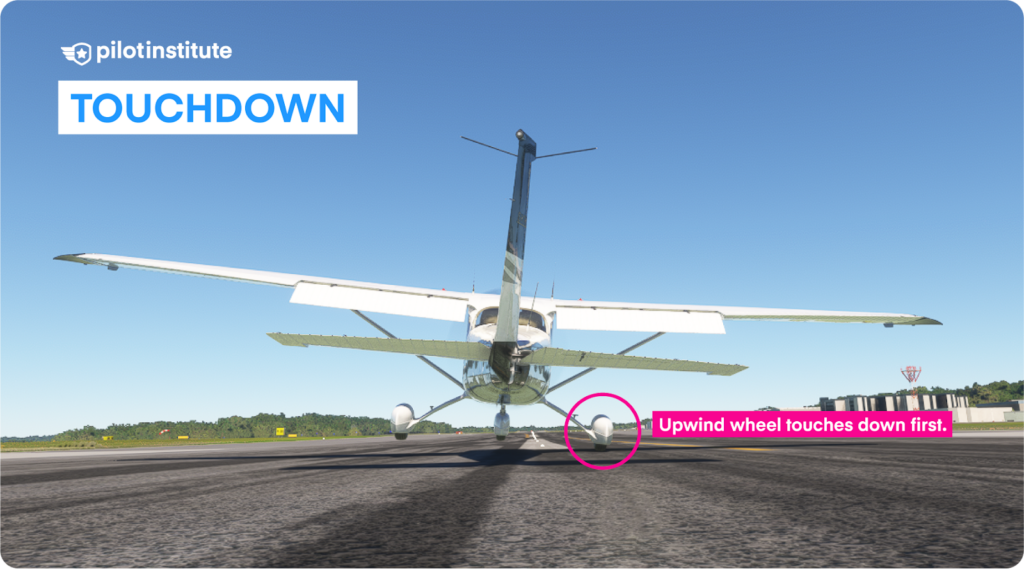
Rollout
Gradually increase to full deflection as you slow down. Keep the aileron deflected into the wind through the rollout. This prevents the crosswind from raising the upwind wing (and wheel), causing a loss of control. High-wing aircraft are particularly vulnerable due to their higher center of gravity.
It’s tempting to breathe a sigh of relief and relax the controls after landing the aircraft. But remember, the crosswind you just battled is still hitting the aircraft’s wing and tail. If you’re not careful, a loss of control is still possible.
Keep the ailerons, elevator, and rudder positioned correctly throughout the taxi. Your job is not over until the aircraft is tied down.
Common Mistakes (And How to Avoid Them)
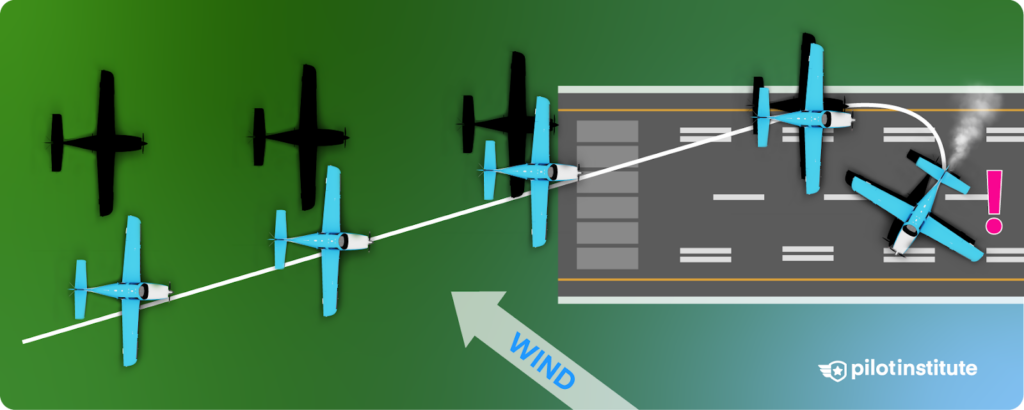
Even experienced pilots can make mistakes during crosswind landings. Let’s cover a few of the most frequent errors.
Failing to Anticipate the Crosswind
Check the winds before the approach to ensure you’ve properly planned for the conditions. Know how strong and from which direction the wind is blowing, and brief how you will handle the approach. Failing to do so can cause ill-timed or incorrect control inputs.
Exceeding Your Personal Crosswind Limits
Get-there-itis and hazardous attitudes often lead to an unhappy ending. If the wind is more than you can safely handle, abandon the approach. Find another airport with lighter winds or a better-aligned runway. The cost of a car rental pales in comparison to damage caused by a runway excursion.
Overcontrolling the Aircraft
Overcontrolling is very common when you’re new to crosswind landings. Touching down smoothly, on centerline, while maintaining a sideslip is tricky to master.
Stay light on the controls and feel where the wind is taking you. Make minor adjustments when necessary. Perform a go-around at the first sign of control issues like ballooning or surprise gusts.
Landing in a Crab
If you don’t align the aircraft before touchdown, you’ll land with a sideload and might lose control. Keep your gaze down the runway and align the aircraft with the centerline. Anticipate the need to increase rudder input as the aircraft slows.
Not Landing on the Upwind Wheel
If you level the wings during the roundout, the wind will blow the aircraft downwind. This can result in the aircraft landing off the side of the runway. Keep the ailerons into the wind during roundout, touchdown, and rollout. As strange as it might feel, you must touch down on the upwind landing gear first.
Neutralizing the Controls on Touchdown
As the aircraft slows down, you need to increase the crosswind control inputs, not decrease them. The aircraft may veer off the runway if you neutralize the ailerons or lighten up on the rudder. Fly the aircraft all the way to the parking spot.
Flying Too Fast
Pilots tend to fly crosswind approaches too fast. A bounce or skip is likely if the aircraft lands while the wing is generating significant lift. Improving your low-speed aircraft control skills will help you perfect your crosswind landings.
Improve Your Crosswind Technique
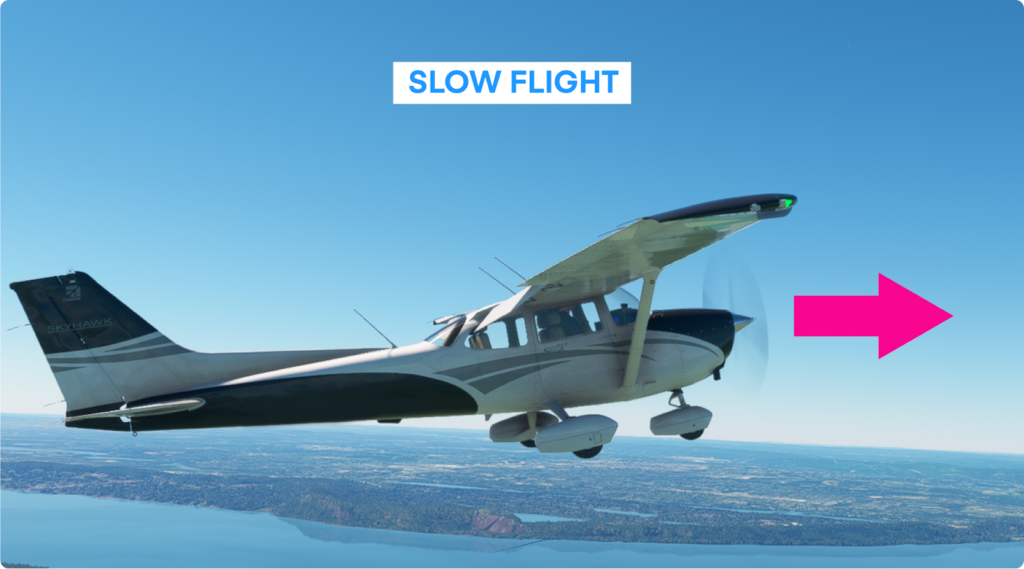
Here are some tips to help build confidence in your crosswind landing skills.
Practice Slow Flight
One of the best ways to improve your crosswind landings is practicing slow flight. This will get you used to mushy controls and low-speed power management. Slow flight will greatly improve your normal, short, and soft field landings as well.
Perform Low Passes
Make low and slow passes over a long and wide runway during crosswind conditions. As you enter the runway environment, transition to a sideslip. Use the rudder to keep the nose aligned with the centerline. Use the ailerons to keep the aircraft in the middle of the runway.
Once you master the rudder and aileron coordination, the landing becomes simple. Reduce the power, and the aircraft will touch down right where you want it to.
Start Small and Build Up
Start with light and gentle crosswinds. Give yourself long finals to allow yourself more time to get used to the wind. Practice regularly, and enlist your CFI to help you work your way up to more challenging conditions.
Pretty much every landing has at least some crosswind. Keep your skills sharp by using the crosswind techniques every time you land. You’ll be well prepared when you have to use them in strong winds!
Conclusion
As pilots, we need to be comfortable flying when conditions aren’t perfect.
Grab your CFI and challenge yourself on some of those rougher days. You’ll be glad you did.Do you want to take your stick and rudder skills to the next level? Consider learning to fly tailwheel airplanes. Read more about getting your tailwheel endorsement here.
